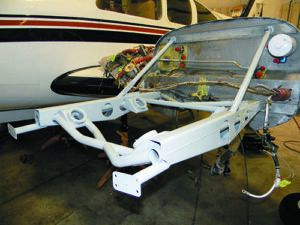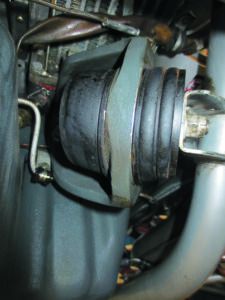Judging by the condition of the engine mounts (technically called engine isolators) we’ve seen on aging piston singles and twins, it’s no wonder that gyro failures, cracked interior components and even structural failures are a nagging problem for some owners. And while some airframes inherently have more perceived vibration than others, aero engineers place vibration into categories: Normal and Abnormal.
If you think your aircraft has more bad vibes than it should, trust your instinct and have it checked. While prop balancing issues can cause substantial vibration, your mechanic may have to dig deep to smoothen it all out. Here’s a review.
ISOLATORS 101
You may not have paid much attention to them, but the elastomer doughnut-like components that are placed between the engine and the airframe to prevent vibration not only live in a harsh environment, they are generally forgotten after being installed. They collect soot, grease, engine blowby grime and generally dry up and deteriorate.
To make matters more challenging for aircraft designers, the ideal aircraft structure is lightweight and rigid to maintain the integrity of the control surfaces. But that’s the perfect setup for transmitting vibration and shock over the length of the airframe. Paul Furhman, senior marketing manager of Lord Corporation, the oldest manufacturer of aircraft vibration isolators, explained that it’s easy to break the transmission path of vibration on a ground vehicle, but difficult to do with an aircraft. The only success is to use elastomeric engine isolators.
Worth mentioning is that the Lord Corporation pioneered the development of rubber vibration isolators (it called them mounts) for aircraft prior to World War II. As general aviation popularity skyrocketed following the war, Lord developed stiff, natural rubber conical mounts for general aviation aircraft that Furhman said were effective in protecting the airframe and instruments from engine vibration. However, they were not very good in damping vibration frequencies that were uncomfortable for the occupants. Furhman said that the vibration in the yoke or stick was often bad enough to cause the pilot significant discomfort over the course of a flight.
In the process of improving its isolators, Lord applied the Dynafocal mount it had developed in the early 1940s to general aviation. The engine mount itself was shaped to point the isolators at the center of gravity of the engine, vastly improving vibration damping. It also mixed other compounds, notably silicon, in with natural rubber, creating isolators that were softer—to absorb more vibration at more frequencies, plus that had improved durability and heat resistance.
REGULAR UPKEEP IS KEY

In general, manufacturers say the isolators will last through engine TBO, but that means they are on the airplane for long periods of time. Many techs will advise replacing isolators at 10-year intervals, depending on the engine and propeller combination.
At the very least, they should be inspected for condition regularly. They are all made of a compound based on natural rubber, which means that they will eventually solidify and deteriorate. Heat shields are usually installed in front of isolators that are near turbochargers or exhaust pipes, but it’s a good idea that any time the cowling is removed, check to see that the heat shield is in place. It’s also common for the isolator located nearest the engine oil dipstick to be the first of a set to degrade. This is because pilots routinely allow a few drops of oil to drip when checking the oil quantity and it finds its way to the isolator.

When isolators wear out, the engine actually sags on the mounting cage and that only worsens vibration. It can even make contact with the engine cowling, wiring harnesses and worse—cut into fuel lines.
Perhaps less critical is the toll vibration takes on avionics and instruments. As an example, the once popular vintage King KG102A remote heading gyro that’s part of the KCS55A HSI system sits on a mount housing equipped with four shock mounts, which proves how critical vibration is to this component (an overhaul nears $3000). The health of the shock mounts can tell a story of how much vibration is present in the airframe, and how long a freshly overhauled gyro might really last.
Most engine mounting systems use four isolators, although some aircraft use six. The Continental engine mounting system supports the engine from below—think of a person holding a beach ball. Lycoming engines are cantilevered out from the firewall, so the top isolators are loaded in tension, the bottom in compression.
Replacing a set of isolators takes anywhere from three to 12 hours. It involves loosening mounting bolts and hoisting the engine a few inches away from the mount, and then loosening or moving cables and lines as needed. Once there is adequate clearance, the bolts can be withdrawn and the replacement isolators installed. But you have to do it right, otherwise you can create vibration like we once witnessed on a high-performance Cessna single. After throwing a lot of money at troubleshooting by looking for a shuddering problem in the wrong places, the mechanics found the problem was a shanked-out isolator bolt. Closer inspection found that the left front isolator was tight in the attachment threads, but not against the structural leg. That play in the mount pack created a heavy, dull vibration felt mostly in a climb configuration as the engine rocked around.
As for cost, isolators aren’t hugely expensive and are generally available from parts supply houses, including Aircraft Spruce. Expect to pay around $200 for common applications, and as much as $1000 for others, not counting labor.
OTHER CULPRITS
When the isolators are healthy, it’s time to look elsewhere. Even a slight imbalance of a control surface can cause a high-frequency oscillation that is dampened by the control cables, but can still be felt in the yoke or stick. Manufacturers are stringent when it comes to trim tab free play.
The main concern is for control surface flutter, which can lead to hinge-point failure and loss of control, but the rattling going on with several loose tabs can be unnerving. While difficult to feel, a slight increase in control wheel or rudder pedal “buzz” can be found by increasing the aircraft speed toward Vne.
It’s even more frustrating when the engine is smooth as silk on the ground, but is vibey in flight. If the vibration is new, consider what if any changes took place. Was the aircraft painted? Was the propeller sent out for overhaul or repair? Even antennas can be problematic. There are reasons why skin doublers are used during antenna installations. We’ve seen enough vibration for some to rip the thickest aircraft skin. That’s a major repair.
No matter the source of vibration, it’s worth the time and expense to figure it out and solve it before a hard failure takes place.


